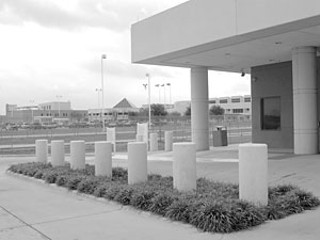Day Trips
The Money Factory is what most people call the Western Currency Facility on the northern edge of Fort Worth
By Gerald E. McLeod, Fri., Dec. 15, 2006

The Money Factory is what most people call the Western Currency Facility on the northern edge of Fort Worth. Don't call it a mint. That's where they make coins. At this federal facility they only make bills. Stacks and stacks of crisp greenbacks.
The Bureau of Engraving and Printing, a branch in the Department of the Treasury, operates two currency printing plants. The factory in Washington, D.C., has been providing the nation with bills, securities, stamps, and engraved announcements since it opened in 1863 in an old brick office building. It took 128 years before the government built a second currency factory.
The Fort Worth facility rolled out its first bills in April 1991. Somewhere on the left side of the front of the American bills (different denominations have it in different locations) is the plate number made up of a small capital letter and a number. If this indicator is preceded by "FW," then the bill was printed in Texas. The Washington plant uses no identifier.
At first the Fort Worth plant printed a wide range of government documents, such as securities, stamps, and Treasury notes, but in the last five years, it has concentrated mostly on producing billions of bills ranging from $1 to $100. Running three eight-hour shifts five days a week, the factory has a capacity of more than 6 billion notes a year. That's a lot of cabbage.
Standing in the hallway looking through the windows down onto the production floor, the pallets of paper look just like that – stacks of paper. It's not until near the end of the 45-minute tour when the operator fans a fresh bundle of bills from the banding machine that it becomes obvious that he's handling cold cash.
Visiting the factory is very much like touring any commercial printing plant with its printing presses the size of railroad box cars churning out 10,000 3-foot-by-3-foot sheets of paper an hour. The difference, as you might expect, is that security is extremely heavy.
The factory looks more like a small prison surrounded by razor wire-topped fences than a print shop, with the exception of a glass roof that resembles the pyramid on a $1 bill. A loudspeaker in the parking lot advises guests to leave their guns, knives, pepper spray, phones, and cameras in the car before being processed through the metal detector. The platoon of heavily armed security guards smiles and advises you not to miss the 15-minute film as you wait for a bus to take you to the printing compound.
Opened in 2004, the visitor center is a museum telling the history of U.S. currency and the Bureau of Engraving and Printing. On display are one-of-a-kind artifacts and showcases filled with encyclopedic information about American money.
What we refer to as paper money is actually made of 75% cotton and 25% linen. Wood-pulp paper could not survive a clothes-washing machine. The life span of a $1 bill is about 22 months, while typical $2 bills will last three years.
The bureau has a group called the Mutilated Currency Division which rescues bills that have been burned, buried at sea, or run through a shredder. Only the front of the bill is actually legal tender, and 51% of it must be recoverable to be replaced. Last year the division processed 30,000 claims for more than $30 million. As you might imagine, they have some interesting stories to tell.
Besides telling the story of money, the visitor center has a gift shop that goes beyond the usual selection of T-shirts, caps, and key chains. Whoever came up with the idea of selling an uncut sheet of 16 $20 bills for $409 was a marketing genius.
The Western Currency Facility is at 9000 Blue Mound Rd. at U.S. 287/81, west of I-35. The visitor center opens Monday through Friday from 8:30am to 3:30pm, except on federal holidays and the week between Christmas and New Year's. In June and July, the hours are extended to 10:30am to 6:30pm. Admission and tours are free. To make reservations, which usually aren't needed except in the summer months, call 866/865-1194, or go to www.moneyfactory.gov.
806th in a series. Day Trips, Vol. 2, a book of Day Trips 101-200, is available for $8.95, plus $3.05 for shipping, handling, and tax. Mail to: Day Trips, PO Box 33284, South Austin, TX 78704.








